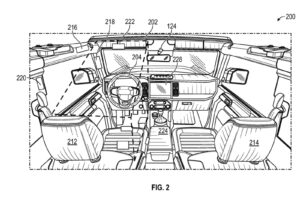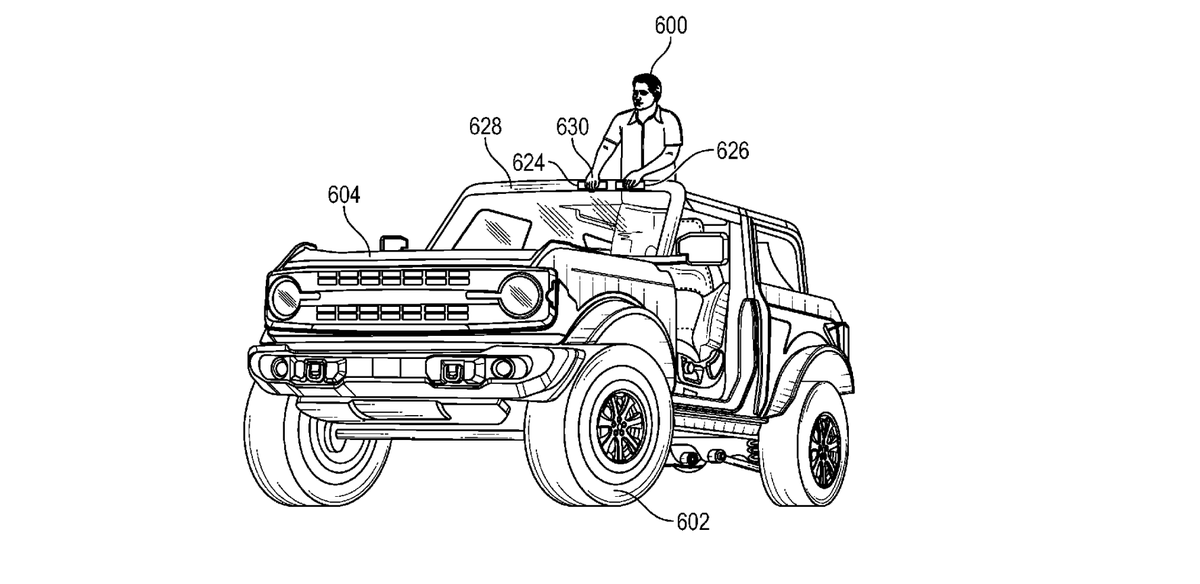The patent filings showcase an interesting technology Ford is exploring for the Ford Bronco. The system addresses visibility issues while off-roading without a spotter. It allows drivers to stand up in their vehicles and control certain aspects of the car’s movement while maintaining a better perspective.

Here are some key features of the system:
- The system would use sensors to detect whether or not the driver is behind the wheel. If the driver is standing up, the system will disable the normal controls and allow the standing controls to be used.
- The standing controls would include a steering wheel and throttle. The steering wheel would be located in the car’s centre, and the throttle would be located on the right side.
- The system would only allow the standing controls to be used at crawling speeds. This prevents drivers from using the system to drive at high speeds.
According to the patent filing, the system would enable drivers to stand in their cars and utilize secondary controls to manage the throttle, steering, and other features while standing up.
The availability of these features would be tied to sensors that detect whether the driver is behind the wheel or standing up, interpreting standing as a specific circumstance for using these controls.
Handy for drivers
By adopting a standing position and utilizing secondary controls, drivers would have improved visibility of obstacles in front of them, allowing them to navigate difficult trails more effectively. This feature could be handy for drivers who tackle challenging off-road terrains without a passenger acting as a spotter.
While the solution seems relatively complex for addressing a specific problem, Ford appears to be exploring this technology as a potential option for the Ford Bronco. It remains to be seen if and when this feature will be implemented in production models.
Pros of the standing control system for off-roading in the Ford Bronco:
- Improved visibility: Standing up in the vehicle would give drivers a better vantage point, allowing them to see obstacles and terrain features. This enhanced visibility can be crucial when navigating challenging off-road trails.
- Better manoeuvrability: By standing up and using secondary controls, drivers may have finer control over throttle input and steering, enabling them to navigate obstacles more precisely.
- No need for a spotter: Off-roading without a spotter can be challenging, as it can be difficult to judge the position and clearance of the vehicle. The standing control system could provide drivers with a viable alternative to having a spotter, potentially increasing their independence on the trail.
Cons of the standing control system for off-roading in the Ford Bronco:
- Safety concerns: Standing up while operating a vehicle introduces safety risks. The driver’s balance and stability could be compromised, especially during extreme off-road manoeuvres. There is an increased risk of injury during sudden stops, impacts, or rollovers.
- Regulatory and legal considerations: Introducing a standing control system raises potential regulatory and legal challenges. Current safety standards and regulations typically require drivers to be seated and properly restrained while operating a vehicle. Implementing such a system would require significant safety evaluations and compliance with relevant regulations.
- Limited practicality: While the standing control system may have advantages, it might not be a practical solution for everyday driving scenarios. Most driving situations, including on-road and less challenging off-road terrains, may not require or benefit from this feature. It could potentially be viewed as a niche functionality with limited widespread use.
- Complex implementation: Designing and implementing a standing control system would require additional engineering and development efforts, potentially increasing the complexity and cost of the vehicle. It may also introduce maintenance and reliability concerns associated with the additional components and mechanisms required for the system.
Conclusion
The standing control system proposed by Ford for off-roading in the Ford Bronco offers advantages in improved visibility and manoeuvrability, as well as the ability to navigate difficult trails without a spotter.
However, several drawbacks and considerations need to be addressed. Safety concerns, including compromised balance and stability while standing, and the potential for injury in accidents, must be thoroughly evaluated.
Regulatory and legal considerations may also pose challenges, as existing standards typically require drivers to be seated and restrained. The practicality of the system may be limited to specific off-road scenarios, and the complex implementation could increase costs and maintenance requirements.
While the concept is intriguing, further development, evaluation, and consideration of these factors would be necessary before implementing such a feature in production models.
United States Patent and Trademark Office and Carbuzz





































